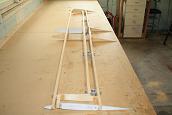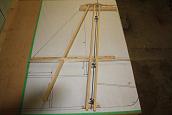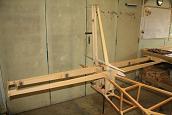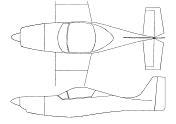
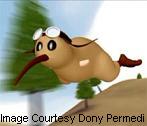
kiwikr.co.nz
|
My Horizontal Stabilser will incorporate a number of changes from the standard KR 2S HS. These include the following; - Firstly my HS will utilise the NACA63009 profiles sourced from Mark Langfords web site. These should reduce drag and improve the effectiveness of both the stabiliser and the elevator. - My HS will also be wider than the standard HS by some one and a half feet taking it to 7ft 6". Widening the HS seems to be "standard practice" for new KR builds as the wider HS improves the pitch stability of the aircraft. - I will also be using Dr Dean type hinges for the elevator. Dr Roderick Dean designed these back in the late 90's and the design uses Rod End Bearings which are effectively self aligning so any small variance in the placement of the hinge mounting holes in the spars won't cause the hinges to bind. - The last major change is that the outer 3" of each side of the HS will incorporate an aerodynamic balance horn. Although I have read on the
net that this type of balance horn tends to make short coupled aircraft like the KR more twitchy, when you read the KRNet archives the opposite
seems to be the case for the KR. Bill Clapp incorporated balance horns on his KR back in the early 2000's and Mark Langford had a chance to fly
it and commented on how stable Bill's aircraft was in pitch and when turning. The balance horns should also reduce the amount of weight required
for the elevater balance weight.
After consulting with my building mentor I have decided to not proceed with using Dr Dean hinges in my HS but will instead use the standard KR hinges. Initially I considered modifying what I had already completed on the existing HS but after looking at what was required I have decided to build a new HS. As such I will start a second HS build page and close off this one. | ||||||
 Sunday 15th November 2009. After reviewing the plans, build notes and a couple of web sites, I made a start on the HS today. I pulled the
lengths of wood for the HS spars from my pack of pre cut wood and checked the dimensions of the timber. I found all three pieces to be slightly
thicker than required so spent about half an hour running them through the thicknesser to get them down to 0.625".
Sunday 15th November 2009. After reviewing the plans, build notes and a couple of web sites, I made a start on the HS today. I pulled the
lengths of wood for the HS spars from my pack of pre cut wood and checked the dimensions of the timber. I found all three pieces to be slightly
thicker than required so spent about half an hour running them through the thicknesser to get them down to 0.625".
| ||||||
 I then spent a couple of hours drawing the dimensions for the ribs onto the spars. For this I used Darren Cromptons dimensions from his
web site which can be found here. Darren has already worked out all the
necessary dimensions for all three spars based on Mark Langfords NACA templates. (Thanks Darren) It was a relatively simple matter of just
working through the dimensions and drawing these onto the spars. Note that I have repeated Darren dimensions below. The dimensions make sense
if you review them in conjuction with looking at Mark Langfords profiles.
I then spent a couple of hours drawing the dimensions for the ribs onto the spars. For this I used Darren Cromptons dimensions from his
web site which can be found here. Darren has already worked out all the
necessary dimensions for all three spars based on Mark Langfords NACA templates. (Thanks Darren) It was a relatively simple matter of just
working through the dimensions and drawing these onto the spars. Note that I have repeated Darren dimensions below. The dimensions make sense
if you review them in conjuction with looking at Mark Langfords profiles.FORWARD SPAR ------------ Total Length = 90 inches Fwd Face Height At Inner Rib = 59mm less 3.9degrees = 56.8mm Fwd Face Height At Outer Rib = 32mm less 7.8degress = 27.6mm Aft Face Height At Inner Rib = 59mm Aft Face Height At Outer Rib = 32mm CENTRE SPAR ----------- Total Length = 84 inches. Fwd Face Height At Inner Rib = 59.5mm Fwd Face Height At Outer Rib = 42.2mm Aft Face Height At Inner Rib = 59.5mm less 3.0degrees = 57.8mm Aft Face Height At Outer Rib = 42.2mm less 2.9degrees = 40.6mm REAR SPAR --------- Total Length = 90 inches. Fwd Face Height At Inner Rib = 52.8mm Fwd Face Height At Outer Rib = 35.6mm Aft Face Height At Inner Rib = 52.8mm less 5.1degrees = 50.0mm Aft Face Height At Outer Rib = 35.6mm less 4.5degrees = 33.0mm | ||||||
 After finishing drawing the dimensions I then made a start on shaping the forward spar. To cut out the spar shape I started by using my
electric plane to cut down the spar to within about a 1-2mm on the final dimension lines.
After finishing drawing the dimensions I then made a start on shaping the forward spar. To cut out the spar shape I started by using my
electric plane to cut down the spar to within about a 1-2mm on the final dimension lines.
| ||||||
 I then used a small hand planer to take the wood down to the dimension lines. I planed down the high side first then flipped the timber over and
planed the low side and match it off against the high side. With care you can get it very close to the final dimensions. Just be sure to
use a sharp plane.
I then used a small hand planer to take the wood down to the dimension lines. I planed down the high side first then flipped the timber over and
planed the low side and match it off against the high side. With care you can get it very close to the final dimensions. Just be sure to
use a sharp plane.
| ||||||
 The final step was to draw file then sand the faces to square them off and clean up any roughness.
The final step was to draw file then sand the faces to square them off and clean up any roughness.
| ||||||
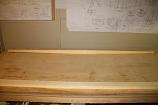 And this is the final result for the front spar.
And this is the final result for the front spar.
| ||||||
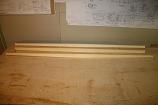 Mon 16th and Tue 17th November 2009. Completed the shaping of the center spar and aft spars.
Mon 16th and Tue 17th November 2009. Completed the shaping of the center spar and aft spars.
| ||||||
 Wed 18th November 2009. I cut out and glued the HS rib templates to some lengths of ply this evening. I cut the templates as accurately as
possible then used PVA glue to wet down the backs and attach these to the ply. Unfortunately during the process of laying the wet templates on
the ply I managed to rip two of the templates. I am not entirely happy with the way this gone and I think I will use spray on adhesive to
attach any other templates I need to make.
Wed 18th November 2009. I cut out and glued the HS rib templates to some lengths of ply this evening. I cut the templates as accurately as
possible then used PVA glue to wet down the backs and attach these to the ply. Unfortunately during the process of laying the wet templates on
the ply I managed to rip two of the templates. I am not entirely happy with the way this gone and I think I will use spray on adhesive to
attach any other templates I need to make.
| ||||||
 Sun 6th/Mon 7th December 2009. Discovered today that some of the templates I had previously attached were the wrong size. I originally only
had two printed copies of the template PDF document and had photocopied the templates at work onto A3 paper. What I didn't realise was that
the photocopier did not accurately copy the originals but had made them about 2-3% larger even though the photocopier was set at 100%.
I didn't notice the difference until after I had the templates cut out and glued onto the ply. Unfortunately I don't appear to have taken a
photo of the pieces showing the different sizes so there is no image to show here. I have decided to use these templates as test
pieces to work out the best way to cut them out.
Sun 6th/Mon 7th December 2009. Discovered today that some of the templates I had previously attached were the wrong size. I originally only
had two printed copies of the template PDF document and had photocopied the templates at work onto A3 paper. What I didn't realise was that
the photocopier did not accurately copy the originals but had made them about 2-3% larger even though the photocopier was set at 100%.
I didn't notice the difference until after I had the templates cut out and glued onto the ply. Unfortunately I don't appear to have taken a
photo of the pieces showing the different sizes so there is no image to show here. I have decided to use these templates as test
pieces to work out the best way to cut them out.
| ||||||
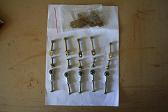 The parts for my DR Dean hinges arrived on the 6th. I ordered these through Steve Noad at Aircraft Logistics in Christchurch. Steve had
nearly all the parts required in stock and gave me prompt and helpful service.
The parts for my DR Dean hinges arrived on the 6th. I ordered these through Steve Noad at Aircraft Logistics in Christchurch. Steve had
nearly all the parts required in stock and gave me prompt and helpful service.
| ||||||
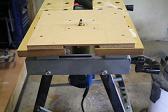 My first thought for cutting out the templates was to make up a jig for my mini router on which I could then use one template as a pattern
to cut the others. This didn't work too well as the router blade kept jumping off the pattern piece as it was too thin. It either miscut the
new piece of ply or damaged the pattern piece. In the end I flagged it away.
My first thought for cutting out the templates was to make up a jig for my mini router on which I could then use one template as a pattern
to cut the others. This didn't work too well as the router blade kept jumping off the pattern piece as it was too thin. It either miscut the
new piece of ply or damaged the pattern piece. In the end I flagged it away.Mon 14th December 2009. The next idea was to cut a thicker pattern piece out of 5mm mdf and then use the cutting jig with my full size router. The pattern worked more or less this time but the finish on the edges of the cut ply was terrible. The router just made a furry mess of the edges. I have decided to stop trying to do this with a router and just buy a scroll saw instead. | ||||||
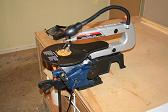 Sun 20th December 2009. I purchased a scroll saw today and also had some new templates printed at a local printer. These are definitely the
right size.
Sun 20th December 2009. I purchased a scroll saw today and also had some new templates printed at a local printer. These are definitely the
right size.
| ||||||
 This time I cut out the patterns from the paper with a large edge around the pattern. I also cut out lengths of plywood about 4" wide
on the bench saw and cut these to roughly the right length for each template. I glued the templates to the ply using Ados spray on adhesive and
used a fine paint roller to smooth out the templates to get a even surface. I started in the middle of the template and rolled to each end. It
was a lot easier to ensure no wrinkles, tears or stretching appeared in the templates using this method.
This time I cut out the patterns from the paper with a large edge around the pattern. I also cut out lengths of plywood about 4" wide
on the bench saw and cut these to roughly the right length for each template. I glued the templates to the ply using Ados spray on adhesive and
used a fine paint roller to smooth out the templates to get a even surface. I started in the middle of the template and rolled to each end. It
was a lot easier to ensure no wrinkles, tears or stretching appeared in the templates using this method.
| ||||||
 After a couple of hours to allow the glue to dry I then used the scroll saw to cut out 3 of the templates. Much, much easier to cut them using
the scroll saw. I really can't believe something that should have been so easy to do has turned out to be so difficult to do.
After a couple of hours to allow the glue to dry I then used the scroll saw to cut out 3 of the templates. Much, much easier to cut them using
the scroll saw. I really can't believe something that should have been so easy to do has turned out to be so difficult to do.
| ||||||
 Tue 5th January 2010. Spent time today finishing cutting out the rib templates using the scroll saw. This included cutting out the holes for
the spars in the templates. I ended up having to recut four of the small templates which will be used in the aerodynamic balance horns as I
initially cut out the centre spar hole and there is no center spar in the balance horn. The photo shows the finished templates.
Tue 5th January 2010. Spent time today finishing cutting out the rib templates using the scroll saw. This included cutting out the holes for
the spars in the templates. I ended up having to recut four of the small templates which will be used in the aerodynamic balance horns as I
initially cut out the centre spar hole and there is no center spar in the balance horn. The photo shows the finished templates.
| ||||||
 I then made the 6mm ply doubler for the HS centre spar. I have intially just cut it roughly to shape to within a millimeter or so of the
final dimension.
I then made the 6mm ply doubler for the HS centre spar. I have intially just cut it roughly to shape to within a millimeter or so of the
final dimension.
| ||||||
 I then glued and clamped the doubler to the center spar and called it a day.
I then glued and clamped the doubler to the center spar and called it a day.
| ||||||
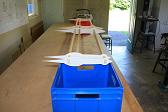 Wed 6th January 2010. With the glue hardened on the centre spar doubler, I finished shaping the doubler to match the centre spar using a small plane,
hand files and then finally sandpaper to finish it off. I then spent a couple of hours adjusting the finish on the main spars so the rib templates
fit over the spars. In most cases this just meant a light filing or sanding of the spar to get it to fit through the templates although one of the
spars required planing away almost a millimeter of wood to get it to the correct size. Have to say the skeleton looks very cool.
Wed 6th January 2010. With the glue hardened on the centre spar doubler, I finished shaping the doubler to match the centre spar using a small plane,
hand files and then finally sandpaper to finish it off. I then spent a couple of hours adjusting the finish on the main spars so the rib templates
fit over the spars. In most cases this just meant a light filing or sanding of the spar to get it to fit through the templates although one of the
spars required planing away almost a millimeter of wood to get it to the correct size. Have to say the skeleton looks very cool.
| ||||||
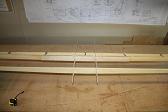 Thu 7th January 2010. Today was spent working out where the Dr Dean hinges will be placed on the spar. I have settled on using a 16" spacing
outward from the center of the HS. This leaves a 10" spacing from the outermost hinge to the outer edge of the centre spar. As you can see from
the photo I am using 5 Dr Dean hinges.
Thu 7th January 2010. Today was spent working out where the Dr Dean hinges will be placed on the spar. I have settled on using a 16" spacing
outward from the center of the HS. This leaves a 10" spacing from the outermost hinge to the outer edge of the centre spar. As you can see from
the photo I am using 5 Dr Dean hinges.
| ||||||
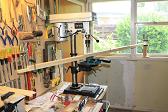 After deciding on the spacing I then marked and drilled the holes for the hinge bolts. The rear spar is offset from the centre spar by
fractionaly over 5mm to allow for the offset between the eye bolt and the rod end bearing.
After deciding on the spacing I then marked and drilled the holes for the hinge bolts. The rear spar is offset from the centre spar by
fractionaly over 5mm to allow for the offset between the eye bolt and the rod end bearing.
| ||||||
 Once the holes were drilled I then fitted the hinges into place and then tried to refit the templates over the spars but immediately struck a
problem in that the gap between the spars is now wider than the template gap by 3/32". As you can see from the picture the templates call for
a spacing of 1.5".
Once the holes were drilled I then fitted the hinges into place and then tried to refit the templates over the spars but immediately struck a
problem in that the gap between the spars is now wider than the template gap by 3/32". As you can see from the picture the templates call for
a spacing of 1.5".
| ||||||
 However with the hinge harware fitted the gap between the spars is 1 - 19/32". Bit of a problem really. I pondered what I had done wrong
for a while and then finally emailed Darren Crompton to ask if he had struck a similar problem. He told me that he had the same issue and
that it was normal and not to stress about it. Once the templates humps are removed the rear spar just moves back the 3/32". He also mentioned
that this apparently doesn't cause any issues aerodynamically but in fact assists in the effectiveness of the elevator - go figure.
However with the hinge harware fitted the gap between the spars is 1 - 19/32". Bit of a problem really. I pondered what I had done wrong
for a while and then finally emailed Darren Crompton to ask if he had struck a similar problem. He told me that he had the same issue and
that it was normal and not to stress about it. Once the templates humps are removed the rear spar just moves back the 3/32". He also mentioned
that this apparently doesn't cause any issues aerodynamically but in fact assists in the effectiveness of the elevator - go figure.
| ||||||
 I finished off the day by cutting out the gaps between the elevator and the stabiliser for the four templates which will move when the HS is
finally assembled. Once the humps are shaved off these templates and the hinges are fitted, the elevator should move freely. The scroll saw
is magic for doing these sort of cuts.
I finished off the day by cutting out the gaps between the elevator and the stabiliser for the four templates which will move when the HS is
finally assembled. Once the humps are shaved off these templates and the hinges are fitted, the elevator should move freely. The scroll saw
is magic for doing these sort of cuts.
| ||||||
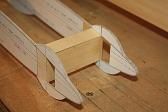 Fri 7th/Sat 9th January 2010. I marked out and cut the small mini spars at the front of the balance horns over the last couple of days. I have
widened the front spar holes to accomodate the mini-spars.
Fri 7th/Sat 9th January 2010. I marked out and cut the small mini spars at the front of the balance horns over the last couple of days. I have
widened the front spar holes to accomodate the mini-spars.
| ||||||
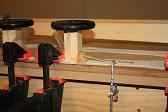 I then glued one side of the mini-spars to the templates after cutting gussets to support the join between the templates and the spars.
I then glued one side of the mini-spars to the templates after cutting gussets to support the join between the templates and the spars.
| ||||||
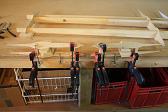 Sun 10th January 2010. Glued the other side of the mini-spars to the templates.
Sun 10th January 2010. Glued the other side of the mini-spars to the templates.
| ||||||
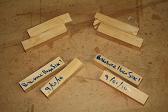 Mon 11th January 2010. Tested the glue joints from the mini-spars today and both failed. Not too happy about that. I have glued together a couple
of other test pieces to check my glueing technique as I had changed to using a spring clamp for the test pieces whereas previously I had been using
small G-clamps and I think the glue is perhaps being almost completely squeezed out of the joint and not leaving enough glue to make a
decent bond.
Mon 11th January 2010. Tested the glue joints from the mini-spars today and both failed. Not too happy about that. I have glued together a couple
of other test pieces to check my glueing technique as I had changed to using a spring clamp for the test pieces whereas previously I had been using
small G-clamps and I think the glue is perhaps being almost completely squeezed out of the joint and not leaving enough glue to make a
decent bond.Tue 12th January 2010. Success. The test pieces I glued yesterday held up under load. It is as I suspected. The spring clamps are applying too much pressure to the joints. | ||||||
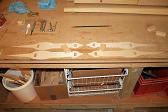 Tue 12th January 2010. I have decided to scrap the balance horns I had previously made as I am not happy with having the mini spar embedded
into the templates. I don't think it will provide enough support for the mini-spar at the front of the balance horn. I now think they should
just be glued between the templates. As such I have cut out four new template pieces and salvaged the mini-spars from the previous attempt
and shortened them to fit between the templates.
Tue 12th January 2010. I have decided to scrap the balance horns I had previously made as I am not happy with having the mini spar embedded
into the templates. I don't think it will provide enough support for the mini-spar at the front of the balance horn. I now think they should
just be glued between the templates. As such I have cut out four new template pieces and salvaged the mini-spars from the previous attempt
and shortened them to fit between the templates.
| ||||||
 Wed 13th January 2010. Cut the gussets for one side of the mini-spars and glued the spars onto the outer templates.
Wed 13th January 2010. Cut the gussets for one side of the mini-spars and glued the spars onto the outer templates.
| ||||||
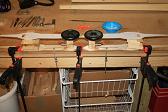 Thu 14th January 2010. Cut the gussets for the other side of the mini-spars and glued the spars into place on the templates.
Thu 14th January 2010. Cut the gussets for the other side of the mini-spars and glued the spars into place on the templates.
| ||||||
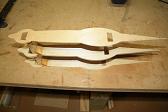 Mon 18th January 2010. I discovered this evening that I have mismatched the templates for the new balance horns. I had cut the templates in pairs
and fitted them to the spars before glueing. Somehow during glueing I managed to swap the templates and now the spar holes are slightly out of
alignment on each pair (approx 1mm). I could force the balance horns on by a bit of judicious filing and applied leverage but I have decided
this is not acceptable so I will scrap the horns and start again. This has been a lesson for me to learn to mark pairs of templates when I make them.
Mon 18th January 2010. I discovered this evening that I have mismatched the templates for the new balance horns. I had cut the templates in pairs
and fitted them to the spars before glueing. Somehow during glueing I managed to swap the templates and now the spar holes are slightly out of
alignment on each pair (approx 1mm). I could force the balance horns on by a bit of judicious filing and applied leverage but I have decided
this is not acceptable so I will scrap the horns and start again. This has been a lesson for me to learn to mark pairs of templates when I make them.
| ||||||
 Tue 19th - Sun 24th January 2010. I ordered a new set of template prints from the printer and picked these up Tuesday. As per previous
implementations, I have glued these to the ply and cut out the templates using the scroll saw. I also marked and cut two new mini-spars for the
front of the balance horns. Sunday evening I set up and glued the mini-spars to the first set of outside templates.
Tue 19th - Sun 24th January 2010. I ordered a new set of template prints from the printer and picked these up Tuesday. As per previous
implementations, I have glued these to the ply and cut out the templates using the scroll saw. I also marked and cut two new mini-spars for the
front of the balance horns. Sunday evening I set up and glued the mini-spars to the first set of outside templates.
| ||||||
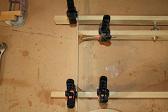 I also cut and fitted gussets to the outer templates of the HS itself. I glued these into place at the same time as glueing the balance horns.
This is the starboard side of the HS.
I also cut and fitted gussets to the outer templates of the HS itself. I glued these into place at the same time as glueing the balance horns.
This is the starboard side of the HS.
| ||||||
 And this is the port side of the HS.
And this is the port side of the HS.
| ||||||
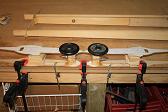 Mon 25th January 2010. I cut and fitted the gussets to the other side on the control horn mini-spars this evening. I made sure this time
that I had the correct matching templates before I started glueing. :)
Mon 25th January 2010. I cut and fitted the gussets to the other side on the control horn mini-spars this evening. I made sure this time
that I had the correct matching templates before I started glueing. :)
| ||||||
 I also cut gussets for the centre templates on the HS and glued these into place as well.
I also cut gussets for the centre templates on the HS and glued these into place as well.
| ||||||
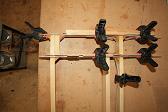 Tue 26th January 2010. After removing the balance horns from the clamps and cleaning up the glue joints, I fitted the balance horns to the HS in
preparation for glueing them in place. I cut and fitted all the gussets required to secure the balance horns and then wIth everything ready I
glued the gussets in place. This is the starboard end of the HS. Note that the ends of the templates look a little warped in the photo but this
is just the angle of the camera lense creating an optical illusion. The templates are indeed straight. Note that I have used 2.5mm ply spacers
between the balance horns and the template at the end of the HS.
Tue 26th January 2010. After removing the balance horns from the clamps and cleaning up the glue joints, I fitted the balance horns to the HS in
preparation for glueing them in place. I cut and fitted all the gussets required to secure the balance horns and then wIth everything ready I
glued the gussets in place. This is the starboard end of the HS. Note that the ends of the templates look a little warped in the photo but this
is just the angle of the camera lense creating an optical illusion. The templates are indeed straight. Note that I have used 2.5mm ply spacers
between the balance horns and the template at the end of the HS.
| ||||||
 And this is the port end with the remaining gussets glued in place. Note that I used a longish piece of 50mm x 14mm pine with duct tape stuck to
one side to clamp the outside gussets against. I used this to ensure I had the rear spar of the HS flush with the outside of the outer template.
This worked quite well. I didn't need to do this for the front spar as I could readily see when I had the spar flush with the outside of the template.
And this is the port end with the remaining gussets glued in place. Note that I used a longish piece of 50mm x 14mm pine with duct tape stuck to
one side to clamp the outside gussets against. I used this to ensure I had the rear spar of the HS flush with the outside of the outer template.
This worked quite well. I didn't need to do this for the front spar as I could readily see when I had the spar flush with the outside of the template.
| ||||||
 Wed 27th January 2010. This evening I removed the clamps from yesterdays glueing and cleaned up the glue joints where required. I then prepared
eight more gussets for the inner templates of the HS. I can usually comfortably manage fabricating 8-10 gussets each night and given there are
nearly 60 gussets in my HS its taking a while to get through them all. I allow about 2 hours for 8-10 gussets which includes measuring, cutting
and fitting them as well as cutting four test blocks. I then prep them for glueing, mix up a batch of glue, glue the gussets in place, clamp them,
clean up any squeezed out glue and then clean up my work bench area afterwards. I don't rush so as to try and not make any mistakes, although this
doesn't always work :-). One other thing to note is that I made sure to remove the paper template from the ply where the gussset needed to be
attached before I glueing the gussets to them. These are the gussets I fitted this evening.
Wed 27th January 2010. This evening I removed the clamps from yesterdays glueing and cleaned up the glue joints where required. I then prepared
eight more gussets for the inner templates of the HS. I can usually comfortably manage fabricating 8-10 gussets each night and given there are
nearly 60 gussets in my HS its taking a while to get through them all. I allow about 2 hours for 8-10 gussets which includes measuring, cutting
and fitting them as well as cutting four test blocks. I then prep them for glueing, mix up a batch of glue, glue the gussets in place, clamp them,
clean up any squeezed out glue and then clean up my work bench area afterwards. I don't rush so as to try and not make any mistakes, although this
doesn't always work :-). One other thing to note is that I made sure to remove the paper template from the ply where the gussset needed to be
attached before I glueing the gussets to them. These are the gussets I fitted this evening.
| ||||||
 Sat 30th January 2010. I fitted the last of the gussets to the centre templates of the HS this evening. This is a photo of the gussets.
Prior to fitting the gussets I had to remove the piece of the paper templates from beneath where the gussets were to be glued. I have had to
do this for 10 of the gussets.
Sat 30th January 2010. I fitted the last of the gussets to the centre templates of the HS this evening. This is a photo of the gussets.
Prior to fitting the gussets I had to remove the piece of the paper templates from beneath where the gussets were to be glued. I have had to
do this for 10 of the gussets.
| ||||||
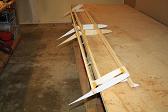 Mon 1st February 2010. Today is a public holiday for the region of New Zeland where I live so I managed to get out in to the shed for about
six hours this afternoon. Today I decided to remove the 'wings' from the HS templates to free up the elevator from the HS. Initially I started
to cut them away using a stanley knife and a hacksaw blade but this proved to be very slow and somewhat clumsy way to do it. I then moved
on to using an electric planer to cut the 'wings' down to about 2mm from the final dimension and then used a dremmel tool with a rotary sanding
wheel to finish them off. This is a photo of the completed HS showing the elevator movement after I fitted all the hinges into place.
Mon 1st February 2010. Today is a public holiday for the region of New Zeland where I live so I managed to get out in to the shed for about
six hours this afternoon. Today I decided to remove the 'wings' from the HS templates to free up the elevator from the HS. Initially I started
to cut them away using a stanley knife and a hacksaw blade but this proved to be very slow and somewhat clumsy way to do it. I then moved
on to using an electric planer to cut the 'wings' down to about 2mm from the final dimension and then used a dremmel tool with a rotary sanding
wheel to finish them off. This is a photo of the completed HS showing the elevator movement after I fitted all the hinges into place.
| ||||||
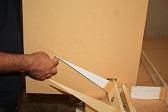 Tue 2nd February 2010. This evening I decided to check the elevator movement to ensure it had the full 30 degree up and 20 degree down movement as
specified on the plans. I cut a piece of MDF to fit over the centre and rear spars and drew the pivot point for the elevator onto the MDF. I
then drew a 30 degree and 20 degree line from the pivot point and used these to check the elevator limits. I found the upper limit to be about 25
degrees while the lower was about 28. As such I only need to adjust the upper range as the lower will be limited to 20 degrees by stops on the
control column.
Tue 2nd February 2010. This evening I decided to check the elevator movement to ensure it had the full 30 degree up and 20 degree down movement as
specified on the plans. I cut a piece of MDF to fit over the centre and rear spars and drew the pivot point for the elevator onto the MDF. I
then drew a 30 degree and 20 degree line from the pivot point and used these to check the elevator limits. I found the upper limit to be about 25
degrees while the lower was about 28. As such I only need to adjust the upper range as the lower will be limited to 20 degrees by stops on the
control column.
| ||||||
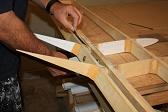 To adjust the upper range I used 100 grade sandpaper to sand the upper round face of the inner templates which are closest to the centre spar
of the HS. By lifting the elevator to its maximum movement I could fit the sandpaper between the spar and the template and then gently sand each
of the templates until the required 30 degrees of movement was achieved.
To adjust the upper range I used 100 grade sandpaper to sand the upper round face of the inner templates which are closest to the centre spar
of the HS. By lifting the elevator to its maximum movement I could fit the sandpaper between the spar and the template and then gently sand each
of the templates until the required 30 degrees of movement was achieved.
| ||||||
| Wednesday 10th February. Tonight I visited with Mike Tunnicliffe to show him progress on the HS. Mike made a number of suggestions including adding ply faces to the spars where the bolts attach and increasing the gap between the balance horns and the main HS body. I left Mike's with a fair bit of work to carry out on the spars but reasonably happy with the results. However later the next day Mike emailed me to say he was not that happy with the Dr Dean hinge setup given the five bolts along each spar basically run along the grain line of the spar in a single line. His main objection was that over time as the wood ages and dries, the line of bolts could firstly loosen and secondly and more importantly they could eventually cause the spars to split along the grain line given the stress from each hinge on the spar is being applied at just a single point. Although I could have argued that this configuration is already flying in aircraft around the world I decided to listen to what Mike said and will change the configuration to use the standard KR hinge setup. | ||||||
| Monday 15th February. After thinking about it for a few days I have decided to not modify the existing HS but will instead build a new one from scratch. I think that modifying what I have already created would probably take just as much effort than just building a new HS from scratch. | ||||||
www.kiwikr.co.nz
